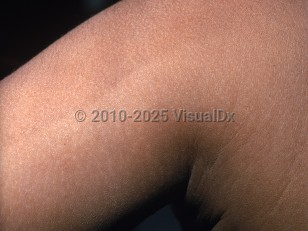While the etiology is unknown, several theories have been proposed. Some postulate that the purpose of the more heavily pigmented dorsal skin is increased sun protection, while others believe that the pigmentary demarcation lines correspond to areas of different cutaneous innervation.
Eight types of pigmentary demarcation lines (designated A to H) have been described, distinguished by their anatomic location and orientation.
- Type A (Futcher lines): A sharply demarcated vertical line located on the anterior portion of the upper arm that may extend onto the pectoral area. This is the most commonly observed type.
- Type B: A pigmentary demarcation line involving the posterior medial portion of the lower extremities. Type B lines have been reported to be associated with pregnancy.
- Type C: A vertical line of hypopigmentation in the presternal or parasternal areas with abdominal extension.
- Type D: Found on the posteromedial area of the spine. This type is the least common, occurring in less than 10% of Black adults.
- Type E: Well-defined bilateral, hypopigmented macules and patches, most often running from the medial third of the clavicle to the periareolar skin. They are present in approximately 15% of Black adults.
- Type F: A V-shaped hyperpigmented line running along the malar prominence or temple.
- Type G: A W-shaped hyperpigmented line running along the malar prominence or temple.
- Type H: A diagonal line from the oral commissure to the lateral aspect of the chin.



 Patient Information for
Patient Information for 
